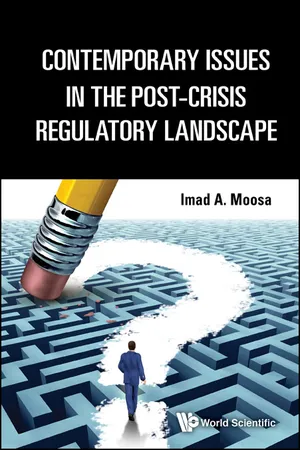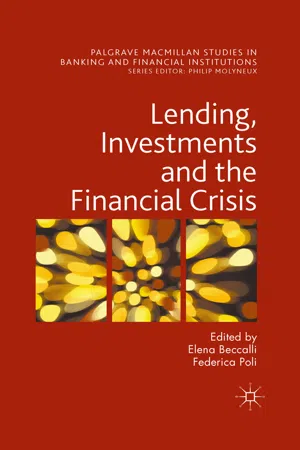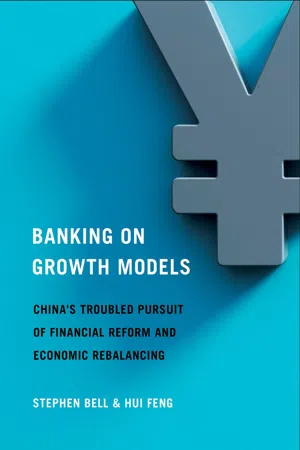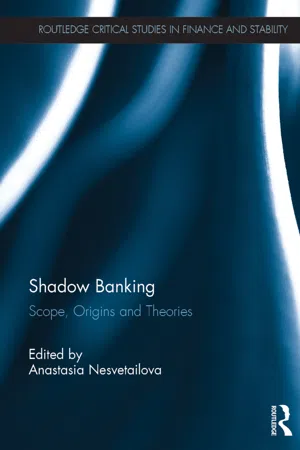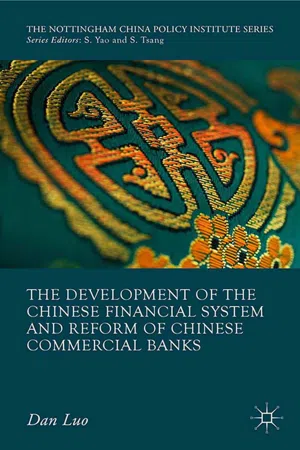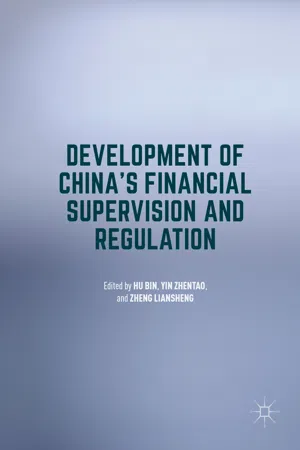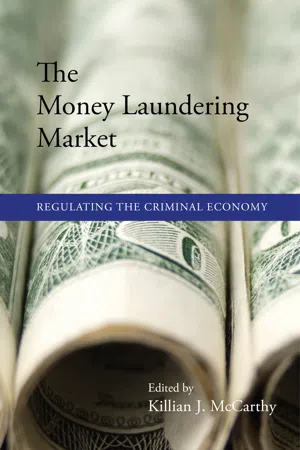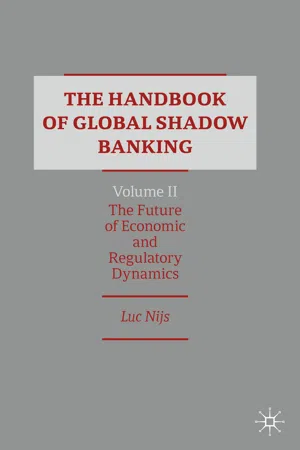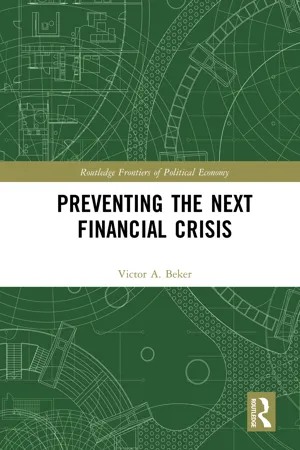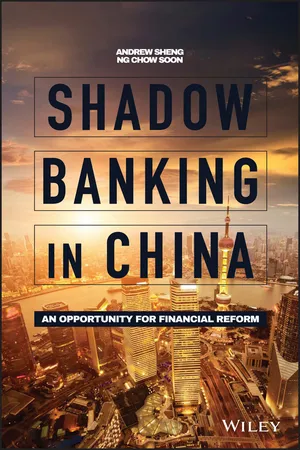Economics
Shadow Banking System
The shadow banking system refers to a network of financial institutions and activities that operate outside the traditional banking sector. These entities provide credit and liquidity but are not subject to the same regulations as traditional banks. Examples include money market funds, hedge funds, and certain types of structured investment vehicles. The shadow banking system can contribute to financial instability due to its interconnectedness with the traditional banking system.
Written by Perlego with AI-assistance
Related key terms
Related key terms
1 of 4
Related key terms
1 of 3
12 Key excerpts on "Shadow Banking System"
- Imad A Moosa(Author)
- 2016(Publication Date)
- WSPC(Publisher)
Shadow banks are financial entities other than regulated depository institutions (commercial banks, thrifts, and credit unions) that serve as intermediaries to channel savings into investment. Securitization vehicles, Asset-backed commercial paper (ABCP) vehicles, money market funds, investment banks, mortgage companies, and a variety of other entities are part of the Shadow Banking System. Before the crisis, the Shadow Banking System had come to play a major role in global finance; with hindsight, we can see that shadow banking was also the source of some key vulnerabilities. . . . Critically, shadow banks were, for the most part, not subject to consistent and effective regulatory oversight.Other definitions of shadow banking can be found in the literature. For example, Baur and Wackerbeck (2013) view shadow banking as encompassing financial intermediaries that indulge in liquidity transformation outside the traditional banking system without access to the liquidity of the central bank and without government deposit guarantees. Pozsar et al . (2010) define the Shadow Banking System as “the network of financial institutions that intermediate through a wide range of securitization and secured funding techniques such as ABCP, asset-backed securities (ABSs), commercial paper, collateralized debt obligations (CDOs) and repurchase agreements”. Plantin (2015) defines shadow banking as “the nexus of financial institutions that perform the functions of traditional banks by financing loans with the issuance of money-like liabilities while not being subject to the prudential regulation of banks”. Agirman et al . (2013) put forward the definition of shadow banking that it is a “wide myriad of highly leveraged non-deposit taking institutions that lend long and borrow short in liquid markets”. According to Pozsar et al- eBook - ePub
- Elena Beccalli, Federica Poli, Elena Beccalli, Federica Poli(Authors)
- 2016(Publication Date)
- Palgrave Macmillan(Publisher)
It is debatable whether the Chinese Shadow Banking System really could be qualified as a ‘sector’ or an ‘industry’, but in this chapter it will be used as a sector for convenience. There are overlapping and different definitions of shadow banking, and its significance in China differs from that in the West. The term shadow banking was first introduced by economist Paul McCulley in 2007who referred shadow banking mainly to non-bank financial institutions that engage in maturity transformation, predominantly through mismatching. Since shadow banks are not subject to traditional bank regulation, these levered-up intermediaries operate ‘in the shadows’ without backstopping from central bank’s discount window or access to a deposit insurance system. The Financial Stability Board (2011) developed a broader definition of shadow banks that includes all entities and activities outside the regular banking system that perform the credit intermediation function of banking, including maturity and liquidity transformation, leverage and default risk transfer. Under this definition shadow banks include broker dealers and money market mutual funds that pool investors’ funds to purchase commercial paper or mortgage backed securities. Standard & Poor’s (2013) defines shadow banking as credit intermediation involving entities and activities (fully or partly) outside the regular banking system in a broad sense and as credit intermediation by non-banks in a more narrow sense which could potentially cause systemic risks or regulatory arbitrage. Claessens and Ratnovski (2014) describe shadow banking as all financial activities, except traditional banking, which require a private or public backstop to operate in the form of a bank or insurance company, or in the form of a government guarantee. Although it is difficult to define and demarcate China’s shadow banking in a manner that enables quantification, it refers to both the business of non-bank financial institutions which provide services similar to traditional banks, but are either lightly regulated or not regulated at all, and it includes the engagement of regular banks in innovative financial products. China’s shadow banking is also characterized by a lack of transparency with improper disclosed risks due to inadequate internal risk management. - eBook - ePub
Cornell Studies in Money
China's Troubled Pursuit of Financial Reform and Economic Rebalancing
- Stephen Bell, Hui Feng(Authors)
- 2022(Publication Date)
- Cornell University Press(Publisher)
The official definition of shadow banking appears in a State Council document, in which it is split into three categories of institutions: credit intermediation institutions that have no financial licenses and are under no regulation, such as internet-based finance and third-party wealth management institutions; institutions that do not have financial licenses and are under limited regulation, such as microcredit and finance guarantee companies; and institutions that have financial licenses but are under inadequate regulation or conduct businesses that evade regulation, such as asset securitization, money market funds, and certain types of wealth management operations (Elliot, Kroeber, and Yu 2015). In a similar vein to the definition used by the Financial Stability Board (2013, 5), perhaps the most succinct definition is by the PBC (2013, 8), which defines shadow banking as “credit intermediation involving entities and activities outside the regular banking system that serves to provide liquidity and credit transformation” and “which could potentially be a source of systemic risk or regulatory arbitrage.” The PBC’s Report on Financial Regulation in China 2014 categorizes shadow banking according to three gauges. The narrow measure is based on whether the operation is under the regulatory radar; these operations include nonlicensed businesses, such as microcredit, financing guarantee, peer-to-peer (P2P) lending, third-party wealth management, and private lending. The intermediate gauge includes the narrow gauge as well as those licensed operations outside banking intermediation, such as trust, wealth management, and bond finance - eBook - ePub
Shadow Banking
Scope, Origins and Theories
- Anastasia Nesvetailova(Author)
- 2017(Publication Date)
- Routledge(Publisher)
It is important to note the use of the term ‘shadow banking’ is not intended to cast a pejorative tone on this system of credit intermediation. The FSB has chosen to use the term ‘shadow banking’ as this is most commonly employed and, in particular, has been used in the earlier G20 communications. Alternative terms used by some authorities or market participants include ‘market-based financing’ or ‘market-based credit intermediation’.p.46This is the first indication that the FSB is uncomfortable with the negative connotations of ‘shadow banking’ and is aware of the existence of more neutral synonyms – ‘neutral’ of course as seen from the perspective of the banking community.In November 2012, the definition is extended with two crucial riders:The ‘Shadow Banking System’ can broadly be described as ‘credit intermediation involving entities and activities (fully or partially) outside the regular banking system’ or non-bank credit intermediation in short. Such intermediation, appropriately conducted, provides a valuable alternative to bank funding that supports real economic activity (my emphasis).Here, shadow banking is officially equated with non-bank credit intermediation and hence rendered harmless in a rhetorical sense. Moreover, it is presented as an alternative means of financing ‘real economic activity’ and hence as the functional equivalent to credit intermediation by banks.One year later, this definition is extended:The Shadow Banking System can broadly be described as credit intermediation involving entities and activities outside the regular banking system. Intermediating credit through non-bank channels can have important advantages and contributes to the financing of the real economy, but such channels can also become a source of systemic risk, especially when they are structured to perform bank-like functions (e.g. maturity transformation and leverage) and when their interconnectedness with the regular banking system is strong. Therefore, appropriate monitoring - D. Luo(Author)
- 2016(Publication Date)
- Palgrave Macmillan(Publisher)
The term ‘shadow banking’ or ‘Shadow Banking System’ was firstly coined by Paul McCulley at the Fed’s annual meeting in 2007. According to him, the Shadow Banking System was ‘the whole alphabet soup of levered up non-bank investment conduits, vehicles, and structures’. In addition, he pointed out that the growth of the Shadow Banking System has posed a major threat to the stability of the US financial system. Although such concern had attracted the attention of the regulators to some extent, it did not raise widespread concerns until the collapse of the US housing market and subprime crisis a year later. Since then, shadow banking activities have been criticized as ‘toxic’, which brought in excessive leverage and systematic risk concerns during the financial crisis. On the other hand, it has also been argued that shadow banking is actually of great importance to economic growth as it provides borrowers with cheaper finance from a much broader lender base. Therefore, it seems that there is a trade-off between the flexibility and price competitiveness brought about by the shadow banking and the additional risks and instability it embedded. It would be up to the regulators to take the balancing act so as to maximize the benefits while ensuring that the risks related to shadow banking have been controlled at an acceptable level.In terms of the definition of shadow banking, no consensus has been reached due to the diversified institutional background of different countries and range of activities encompassed.In its 2013 Global Shadow Banking Monitoring Report, the Financial Stability Board (FSB) defined shadow banking broadly as ‘credit intermediation involving entities and activities outside the regular banking system or non-banking credit intermediation in short’, while the study of Pozsar et al. (2013) provided a narrower description of shadow banks, defining them as ‘financial intermediaries that conduct maturity, credit, and liquidity transformation without explicit access to central bank liquidity or public sector credit guarantees’ (p. 1). Therefore, according to the definition, it is clear that the operations of the shadow banks are similar to those of the other banks, borrowing short-term funds from the money markets and lending them out with much longer maturities. However, because they are not subject to traditional banking regulation and could not get access to the emergency funds of the Fed, their operation is said to be in the ‘shadow’. Moreover, unlike traditional banks whose deposits are covered by publicly guaranteed deposit insurance or lenders’ last resort from central banks, shadow banks are inherently more susceptible to bank runs in cases of liquidity shocks.- Bin Hu, Zhentao Yin, Liansheng Zheng, Bin Hu, Zhentao Yin, Liansheng Zheng(Authors)
- 2016(Publication Date)
- Palgrave Macmillan(Publisher)
The explosive growth of shadow banking has raised both intrigue and concern among experts, as it has significantly changed the structure of the global financial system. Since the 2008 financial crash, international regulatory agencies and organizations have been conducting extensive research on the topic. Shadow banking in China has sparked huge debate over its definition, scale and potential off-balance-sheet risks. The China Banking Regulatory Commission (CBRC) has issued Regulatory Document no. 8, concerning off-balance-sheet wealth management products, and Document no. 107 (“Notice of the General Office of the State Council on Enhancing Regulation of Shadow Banking”). Since publication of these documents the focus has shifted from systemic financial risks arising out of the Shadow Banking System to the division of regulatory responsibilities and the coordination of regulation.This chapter clarifies the basic concepts, scale and risks of shadow banking in China. It also offers several policy suggestions to tackle regulatory issues.1.1 Shadow Banking System: Controversy and Evolution
American economist Paul McCulley coined the term shadow banking in 2007. A year later, Timothy Geithner, then president of the Federal Reserve Bank of New York, called it “the parallel banking system.” Shadow banking refers to non-banking financial institutions. Examples include investment banks, private equity funds, money-market mutual funds, mortgage intermediaries, hedge funds, bond insurance companies, and structured investment vehicles.In 2012, the European Central Bank described shadow banking as a credit intermediary outside the regulated banking system. The popular “originate-to-distribute” model allows the bank to transfer a regulated asset on the balance sheet to an unregulated off-balance sheet. With the widespread application of securitization vehicles, the evasion of relevant regulation is of particular significance.Scholars are divided when it comes to the definition of shadow banking. The most authoritative description so far comes from the Financial Stability Board (FSB). It provides a broader definition of shadow banks to include all entities outside the regulated banking system that perform credit intermediation. The FSB established four fundamental features of shadow banking: maturity transformation, liquidity transformation, leverage, and credit-risk transfer. The FSB’s definition of shadow banking has gained worldwide recognition. However, since the FSB only follows the Eurozone and 25 other economies, its definition may not apply to all economies and policy frameworks.1- eBook - ePub
Illicit Industries and China's Shadow Economy
Challenges and Prospects for Global Governance and Human Security
- Victor Teo, Sungwon Yoon(Authors)
- 2018(Publication Date)
- Routledge(Publisher)
Yet, the section still does not tell us exactly what shadow banking is or specify the range of activities that are involved 27 Shadow banking has the general characteristic of being ‘wide-ranging and sometimes complex forms of activities that takes outside the traditional banking activities of deposit and lending’. 28 The World Bank defines shadow banking as ‘comprising a set of activities, markets, contracts, and institutions that operate partially (or fully) outside the traditional commercial banking sector, and as such are either lightly regulated or not regulated at all’. 29 The IMF’s Global Financial Stability Report defines shadow banking as credit intermediation involving entitles or activities by non-banks; this approximates the definition of the Financial Stability Board (FSB), which broadly describes Shadow Banking as ‘credit intermediation involving entities and activities outside the regular banking system’. 30 In the case of China, the IMF further defines shadow banking as financial intermediation outside the regulated banking system, and establishes this to be one-fourth of total financial intermediation worldwide. 31 The IMF also specifies that shadow banking tends to flourish when tight banking regulations combine with ample liquidity and when it serves to facilitate the development of the rest of the financial system. 32 China is considered as the exceptional case of exponential growth in the fraternity of emerging economies - eBook - ePub
The Money Laundering Market
Regulating the Criminal Economy
- Killian J. McCarthy, Killian McCarthy(Authors)
- 2018(Publication Date)
- Agenda Publishing(Publisher)
4 THE Shadow Banking System Ulrich Andreas Zanconato* 4.1 INTRODUCTIONIn recent years, shadow banking has attracted increasing interest. The discussion focuses mostly on its contribution to the financing of the real economy – mainly in periods in which real bank finance dries up – and on its role as a source of systemic risk: that is, risk for the stability of the finance system (van der Veer et al. 2015). A less researched field is the role played by shadow banking in the laundering of illicit funds. The purpose of this chapter is to shed light on the ML risk of shadow banking and offer a view on whether ML can effectively be mitigated, and to what extent it is worthwhile doing so.While reference is here generally made to ML, the same applies to terrorism financing too, as both utilize largely the same techniques. Terrorism financing can indeed be described as the inverse process of ML, where licit funds are diverted for the financing of illegal activities. The preparation of bribery offences also involves the diversion of licit funds into dark pools, which can later be used to bribe officials making the detection of bribery more difficult. Hence, ML means here both concealing the unlawful source of criminal gains and concealing the existence of licit funds for the purpose of preparing criminal offences.4.1.1 Shadow banking: a definitionThe Financial Stability Board Global Shadow Banking Monitoring Report 2015 describes shadow banking as credit intermediation involving entities and activities outside the regular banking system. It is also often referred to as “market-based financing”. A unique definition does not exist, as shadow banking activities can take very different forms across countries, and definitions focus either on the entity performing the activity or the activity itself. Until 2014, the FSB adopted an entity-based definition and, in 2015, it introduced an activity-based “economic function” measure of shadow banking, which aims to narrow the focus to those parts of non-bank credit intermediation where shadow banking risks – from a systemic risk perspective – are more likely to occur. As mentioned above, the purpose here is to analyse, not the systemic risk of shadow banking, but the ML risk residing in less regulated credit intermediaries. The shadow banking sector is thereby broadly defined here as covering non-bank financial intermediaries, besides insurance companies, pension funds and public financial institutions.1 - eBook - ePub
The Handbook of Global Shadow Banking, Volume II
The Future of Economic and Regulatory Dynamics
- Luc Nijs(Author)
- 2020(Publication Date)
- Palgrave Macmillan(Publisher)
Wide variations and deviations from the global FSB shadow banking definition occur. As a reminder that definition was ‘credit intermediation involving entities and activities (fully or partially) outside the regular banking system’. Many of the supervisors in the region interpret that FSB definition differently—that is, ‘some jurisdictions interpret “credit intermediation” in such a way to only include investment in debt instruments, while others include investments in equity or other financial assets’. 24 Nevertheless regulators in the region tend to use a set of economic criteria that seems to embody at least the philosophy of the FSB and which include ‘economic substance’, ‘credit intermediation activities’, involvement in ‘maturity/ liquidity transformation, leverage and credit risk’, ‘connectedness with the rest of the financial system’, ‘potential of creating systemic risks’, ‘potential for regulatory arbitrage’. A particular point of contention includes the inclusion of and position of NBFI within the shadow banking segment. Some supervisors don’t consider NBFIs as part of the shadow banking segment in case ‘(1) the NBFIs are subject to an appropriate regulatory regime; (2) the risks generated by their activities are not considered systemic; or (3) they do not carry out credit intermediation activities’. 25 That has led to a great variety of definitions and interpretations among Asian supervisors where the essence comes down to the delineation between those NBFIs that are part of the regular banking system and essentially considered banking institutions (credit unions, building societies) and remaining NBFIs which are only considered shadow banks where credit intermediation is involved. 5.4 A Further Examination of the Demarcation Line Between NBFIs and Shadow Banking The issue of the ‘fine line’ between NBFIs and shadow banking entities and activities didn’t go away, and so a further examination was requested - eBook - ePub
- Victor A. Beker(Author)
- 2021(Publication Date)
- Routledge(Publisher)
However, the presence of the Shadow Banking System allows leverage to rise quickly in both individual banks and the banking system as a whole. Banks intensified their reliance on other financial institutions for funding, increasingly relying on the wholesale capital markets for repos and commercial paper. As a consequence, funding to banks was increasing during the pre-crisis period until it involved much more than just households and their deposits. 1 For example, the growth of the market for repurchase agreements zoomed upward from $1 trillion in 2001 to $4.3 trillion by the time Bear Stearns went down in March 2008, reflecting a level of borrowing from other financial institutions that fueled leverage and expanded the size of positions taken through proprietary trading. (D’Arista, 2011) Although the development of the Shadow Banking System had its core in the US, off-shore jurisdictions like the Netherlands, Luxembourg and Ireland have been instrumental for providing crucial infrastructural services to large financial agents, in the form of tax avoidance, regulatory arbitrage and the facilitation of what is called “financial innovation,” as Engelen (2017: 55) remarks. The “originate-to-distribute” model developed thanks to deregulation and financial innovation allowed banks to originate a variety of loans and then transfer the risks associated with these loans to non-bank institutions. Securitization allowed bundling up several tranches of illiquid loans together and converting them into liquid financial securities apt to be sold to investors. The largest investment banks, connecting the different shadow bank entities through their role as dealer, broker and underwriter, were pivotal nodes in the Shadow Banking System. Due to the lower quality of the loans they finance, shadow banks make the financial sector highly fragile - eBook - ePub
- William Tabb(Author)
- 2012(Publication Date)
- Columbia University Press(Publisher)
4 The Shadow of the Financial System Ever since Jesus in the Temple dealt harshly with the hedge-fund managers of his time, many Christians have been suspicious of finance.—JOHN MICKLETHWAIT, 2007Why we are in this situation seems utterly incomprehensible. Who but a Wall Street trader or a professor of economics can say exactly what a “derivative” is, or a “credit-default swap,” and why they are responsible for so many people losing their jobs?—RUSSELL BAKER, 2009T raditionally, banking was understood as consisting of banks that took deposits and made loans that were held to maturity, when the debt was repaid, with interest payments made along the way. Depositors’ savings anchored lending. This system eroded over the decades of the global neoliberal SSA as shadow banking activities became an outlet for capital seeking higher returns, given the lack of investment opportunities with comparable returns in the nonfinancial economy. With profits down in many areas of the real economy in the mature markets of the core, investment banks seeking higher returns put greater amounts of capital at speculative risk by leveraging their own money, borrowing vast sums. What made the situation of the banks and others so fraught with danger was the premise behind the extensive borrowing. As Henry Kaufman (2009a:11) points out, “Traditionally, liquidity was an asset-based concept. But that shifted to the liability side, as liquidity came to be virtually synonymous with easy borrowing.” Commercial banks, too, borrowed large sums and relent the money, often to those who speculated with it.From the start of the global neoliberal era, commercial banks received more and more of their income in fees, guaranteeing commercial paper, on credit cards, and from following investment banks into proprietary trading on their own account through affiliates. The Fed allowed the presumably regulated commercial banks, which had become bank holding companies, to expand into formerly forbidden activities and set up special-purpose vehicles to carry out unregulated activities to get around capital requirements, and so the whole 1930s system was basically gone by the new century. Segmentation of the industry crumbled completely in 1999 when the Gramm-Leach-Bliley Bank Reform Act allowed banks to own all manner of subsidiaries, and the line between investment banks and commercial banks faded. Indeed, the one thing that continued to separate them—federal insurance and support for commercial banks but not for investment banks and finance companies—ended in the crisis as investment banks and finance companies such as GE capital received the same cover and support through fig-leaf formalities in 2008. Earlier in the decade Citigroup, parent of Citibank, earned most of its net revenue from other than interest on loans: from vastly expanded fee income, much of it from alternative investments in private equity, hedge funds, and structured products; and from providing services for fee income to other financial firms. Given the interdependencies generated and other changes in the industry, it does not make sense to see a regulated banking sector and a second or separate Shadow Banking System. - eBook - ePub
Shadow Banking in China
An Opportunity for Financial Reform
- Andrew Sheng, Ng Chow Soon(Authors)
- 2016(Publication Date)
- Wiley(Publisher)
Shadow banking has challenged the traditional deposit-taking business model of commercial banks. Such challenge, however, has promoted the banking reform process and interest rate liberalization. Banks are now reconsidering their business model in the face of the challenges of both technology (e-finance) and market competition from shadow banking institutions.As indicated above, the close interconnectivity between shadow banking activities and traditional banking business implies that shocks in any sector could be transmitted rapidly to other sectors. However, there are fundamental issues like the high level of inter-enterprise credit and lack of access by SMEs to equity capital, working capital and long-term funding, that must also be addressed.4.6.1.5 Impact on Capital Market
On the positive side, shadow banking has promoted the deepening of the capital market by widening the tools and instruments of both indirect financing and direct financing. Privately led informal lenders often play the role of “merchant banks,” by taking over inefficient borrowers and improving their asset utilization and efficiency. New forms of microcredit lending, P2P lending and private/informal lending give SMEs alternative choices of funding.On the negative side, because shadow banking still relies on the official banking sector for funding, it has not improved significantly a major deficiency of the capital market, which is its limited capacity in raising equity capital for SMEs, for innovation and higher-risk higher-return ventures. A fundamental problem of the Chinese financial sector is its overreliance on the banking system, which is short-term in outlook, and based on debt financing. If leverage continues to increase, the system is inherently fragile. If the capital market does not evolve new forms of equity fund raising for SMEs and for innovation and growth, the system will continue to be short-term biased and become vulnerable to maturity mismatches.
Index pages curate the most relevant extracts from our library of academic textbooks. They’ve been created using an in-house natural language model (NLM), each adding context and meaning to key research topics.
Explore more topic indexes
Explore more topic indexes
1 of 6
Explore more topic indexes
1 of 4
